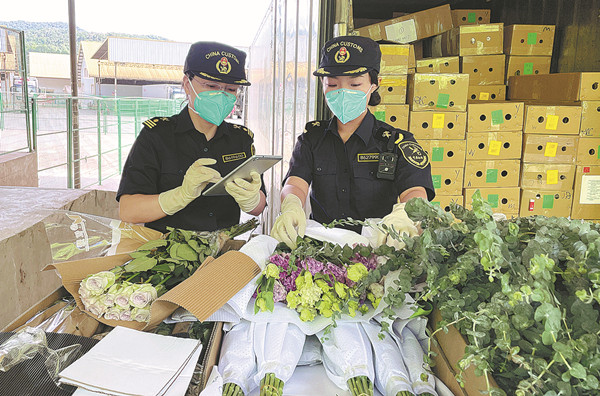Chanthone Sithixay, chairman of Vientiane Logistics Park Co, called the rail link "a new milestone" in freight transit and transportation between the 10 member states of the Association of Southeast Asian Nations and China, the world's second-largest economy.
The link "will streamline the transportation system and save time and money", he said. "This offers huge advantages to businesses in Laos, China and Thailand as well as other business operators across the region."
As part of the China-proposed Belt and Road Initiative, the China-Laos Railway also connects to the China-Europe Railway Express, linking ASEAN nations to European markets through a cost-effective transportation system.
Yuan Minghao, general manager of China-Laos Railway Co, said that as the China-Laos Railway heads north, it connects to rail networks that reach major Chinese cities including Chengdu, Sichuan province; Chongqing municipality; Wuhan, Hubei province; and Xi'an, Shaanxi province, as well as many logistics distribution centers in China and along the route of the China-Europe rail line.
Heading south, the railway links the transportation networks that reach several major ports, including Thailand's Laem Chabang Port and Singapore.
"Over time, (the railway and connected networks) will become a new land and sea transport link and connectivity route," Yuan said.
Panya Paputsaro, president of Thailand-based Kaocharoen Train Transport Co, said he was able to cut transportation costs by up to 40 percent when shipping containers by rail from Thailand to Europe, compared with the cost to transport by sea.
Meanwhile, something more than the railway is turning Mohan into a bustling town.
On August 31, 2015, as witnessed by President Xi and then Laotian president Choummaly Sayasone, the agreement for the Mohan-Boten Economic Cooperation Zone was signed on behalf of the two countries.

Customs officers from Mengla county in Yunnan inspect flower exports at the Mohan land port in July. ZHANG XINYUE/FOR CHINA DAILY
Facilitating investment
China and Laos decided to build and develop the zone on the border between Yunnan and Laos' province of Namtha. It is the second cross-border economic cooperation zone established by China and a bordering country; the first was the China-Kazakhstan Horgos International Frontier Cooperation Center.
The Mohan-Boten Economic Cooperation Zone will promote the economic complementarity of the two countries, facilitate trade investment, promote industrial cooperation and accelerate the development of the border area of the two countries.
As a result, Mohan is being transformed from a "backwater" area to a "bridgehead" of China's socioeconomic development within the specific context of the country's antipoverty campaign.
Ai Xiang, chairman of the Standing Committee of the Mohan Township People's Congress, has worked in the town for 27 years.
"There were 10,000 residents living in Mohan 10 years ago, when the town was not easily accessible, and people could hardly make ends meet," said Ai, who added that the annual income of a local household at that time was 8,000 yuan.
"In the past decade, we now have a highway and a railway," Ai said. "All the 66 villages of the town are now accessible by asphalt or concrete roads."
The town now has a population of 25,000, with per capita income of 14,000 yuan a year.
With the advantages of a shorter transportation time, lower logistics costs and higher safety and environmental protection, international freight via the China-Laos Railway has developed rapidly.
International freight trains from more than 20 cities are quickly cleared through customs. The transportation network connects the Bohai Economic Rim, the Yangtze River Delta and the Pearl River Delta, and it covers Laos, Thailand, Cambodia and other Southeast Asian countries.
The cooperation zone has become an important logistics channel to drive the economic and trade development of China, Laos and other Southeast Asian countries.
The travel time from one end of the rail line to the other is approximately 10 hours-well below the current road time of about 30 hours-and transportation costs between Vientiane and Kunming have been reduced by more than 30 percent, according to the Assets Supervision and Administration Commission of the State Council.
Du Yongzhi, who is in charge of the Mohan office of Haihan Logistics Co, which deals with imports and exports between China and Laos, spoke highly of the safe and efficient customs clearance mode established for the China-Laos Railway and the Mohan-Boten Economic Cooperation Zone.
"It helps cut the costs of our operation. As a result, we can sharpen our cutting edge in foreign trade," Du said.
The railway is expected to increase trade flow between China and Laos, from 1.2 million metric tons in 2016 to 3.7 million tons by 2030, including 2 million tons shifted from maritime to rail transportation, according to the World Bank.
Since the railway was launched, a total of 647,000 metric tons of international cargo has been imported and exported via the rail, according to Kunming Customs.
Goods delivered
Goods such as cattle feed, daily necessities and mechanical and electrical products from 21 Chinese provinces, autonomous regions and cities were transported via the China-Laos Railway to 10 Southeast Asian nations. Imported cargo included iron ore and charcoal from Southeast Asia, Kunming Customs said.
Xia Yingjiang of Yunnan Tianchi Logistics said that when the company previously sent chemical fertilizer to Southeast Asia, the goods had to go by train from Yunnan to the Guangxi Zhuang autonomous region, and from there continued the journey by sea to various destinations.
"It took a lot of time, and we spent a lot of money," Xia said. "Now, we go by the China-Laos Railway, which saves time and money."